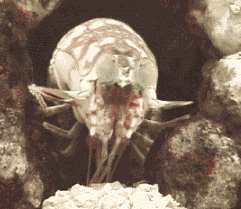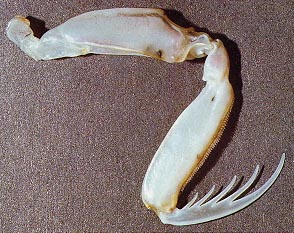How smashing!
The earliest stomatopods with raptorial appendages (“raps”) were “spearers,” with sharp barbs on their raps used to impale fish, shrimp, or other soft-bodied prey. Spearers are lightning-fast: it takes only two milliseconds (2/1000 of a second) for a spearer to extend its rap! In contrast, the blink of an eye is 100 milliseconds. The strike is similar to that of the insect praying mantis, which earned the stomatopods their common name of mantis shrimp, but the stomatopod strike is at least 10 times faster.

The rap of a “smasher” with a tough heel (marked by the red arrow).

|

The rap of a "spearer" with sharp barbs.
Shortly thereafter, some groups of stomatopods developed into “smashers,” with an inflated, calcified “heel” on their raptorial appendage. They use this club to smash the shells of snails or clams, feeding on the soft animals inside.
The smashers are incredibly powerful: one species of stomatopod that is around 5 cm (2 inches) long, preys on snails that are half its size! If a smasher were the size of a human, the force of its “punch” would be equivalent to a small caliber gun! Lucky for us, the largest smashers are only about 25 cm long, but even at this size they pack such a punch that unlucky fishermen who have caught them call them “thumb busters”!
What do these marvelous appendages look like in action? Click on the button to view an animation! Note the heel, marked by the red arrow at the end of the animation.

|


